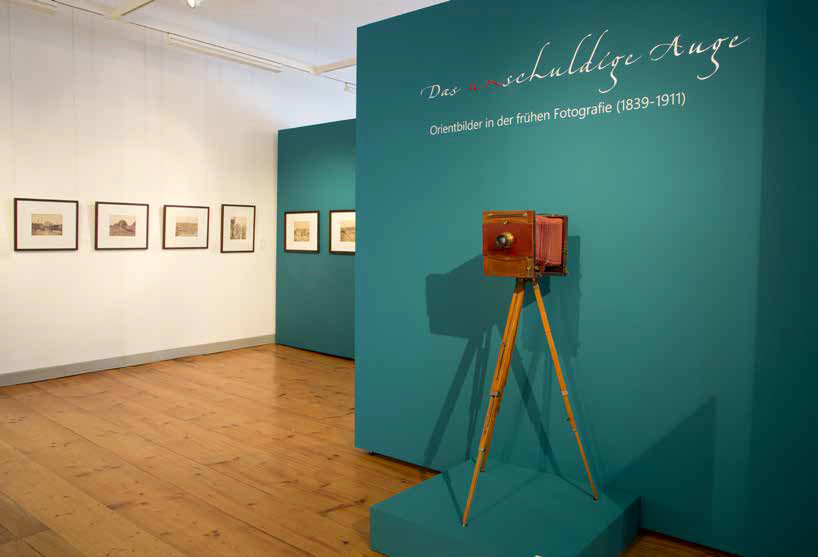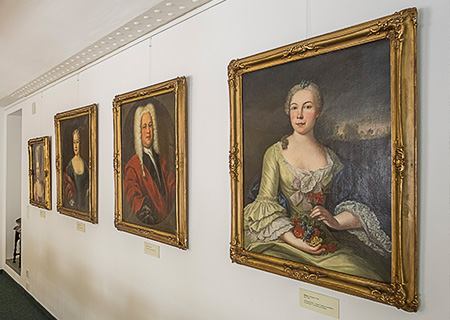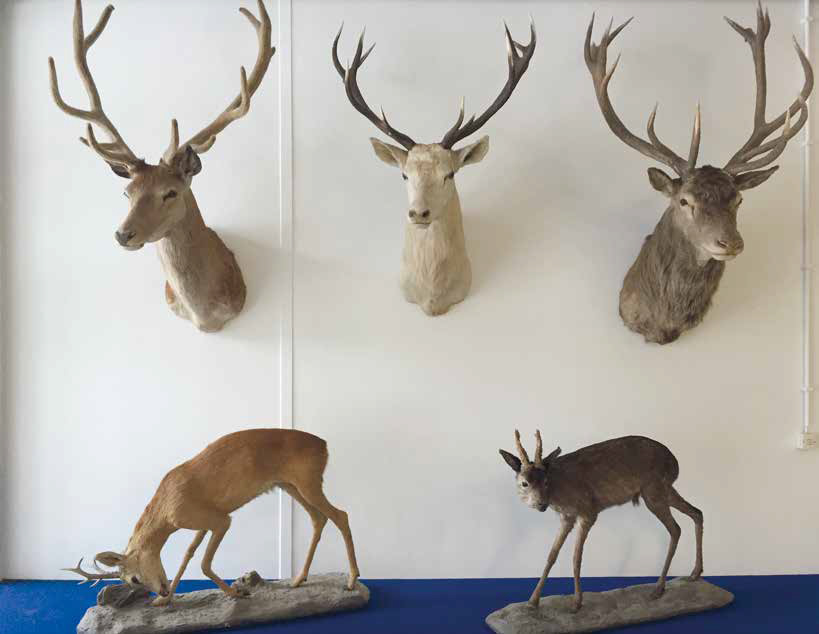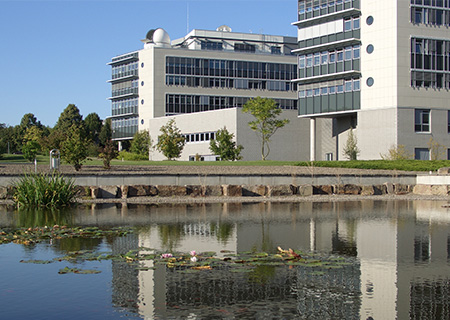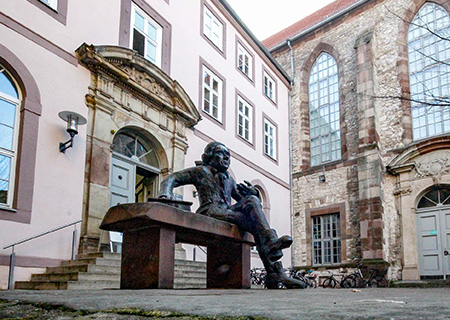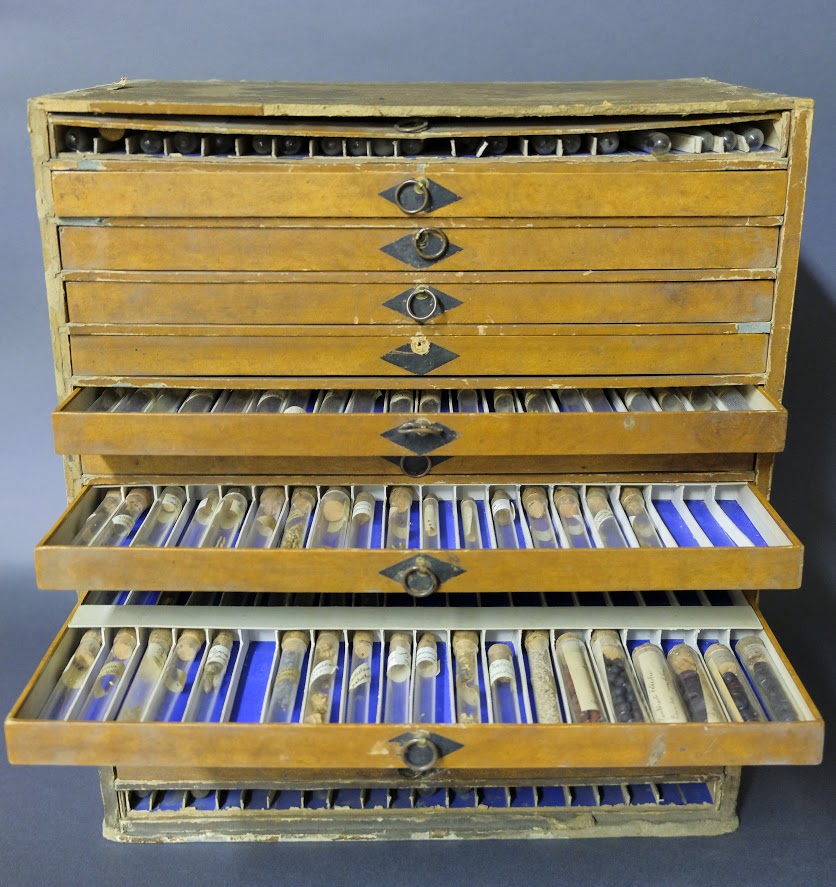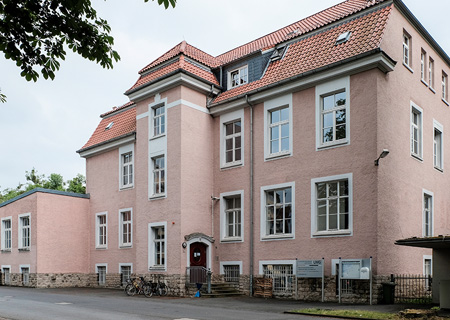Archäologische Originalsammlung
Die Institutssammlung von Originalwerken der Skulptur, der Keramik und anderer Gattungen des antiken Kunsthandwerks geht in die Frühgeschichte der Universität Göttingen zurück und ist bis heute wesentliche Ressource der Forschung und Lehre des Archäologischen Instituts.
Ethnologische Sammlung
Die Ethnologische Sammlung der Universität Göttingen ist eine der bedeutendsten Lehr- und Forschungssammlungen im deutschsprachigen Raum. Ihre Anfänge reichen bis in die Zeit der Aufklärung zurück. über zwei Etagen verteilen sich die Regionen Amerika, Asien, Australien, Ozeanien und Afrika.
Fotografische Sammlung
Bereits unter der Direktion von Friedrich Wilhlem Unger, der von 1863 bis 1876 für die Kunstsammlung tätig war, sowie unter Rudolf Hermann Lotze (1817–1881) wurden einige Fotografien angeschafft und als Schenkungen angenommen. Es ging darum, mit der damals noch neuen Technik, einen wissenschaftlichen Lehrapparat an Abbildungen aufzubauen, der die bereits vorhandenen Sammlungen an Gemälden, Druckgrafik und Zeichnungen ergänzen sollte.
Gemäldesammlung
Die Kunstsammlung der Göttinger Universität gehört mit 300 Gemälden, 2.500 Zeichnungen, 15.000 Blatt Druckgraphik und 100 Skulpturen auch international zu den großen Sammlungen ihrer Art in universitärem Besitz. Hinzu kommen rund 150 Werke von Videokünstlern aus aller Welt. Die in der zweiten Hälfte des 18. Jahrhunderts durch Stiftungen des Frankfurter Patriziers Johann Friedrich von Uffenbach und des Gerichtssekretärs Johann Wilhelm Zschorn aus Celle.
Grafische Sammlung
Bereits 1736 vermachte der Frankfurter Patrizier Johann Friedrich Armand von Uffenbach (1687 – 1769) der erst ein Jahr später offziell gegründeten Georgia Augusta einen großen Teil seiner Sammlungen, darunter etwa 10.000 Blatt Druckgrafik.
Skulpturensammlung
Der Skulpturenbestand der Georgia Augusta lässt sich insgesamt in drei unterschiedliche Bereiche unterteilen. Zum einen beinhaltet er Büsten aus Marmor und Gips, welche die für eine Universitätssammlung typischen bedeutenden Persönlichkeiten der Universitätsgeschichte darstellen.
Musikinstrumentensammlung
Die Musikinstrumentensammlung der Universität Göttingen zählt mit 2.164 Objekten (Stand: 06/2021) zu den größten Sammlungen ihrer Art in Deutschland. Ihr Bestand umfasst vorwiegend Musikinstrumente Europas, Afrikas (einschließlich Altägyptens) und Asiens.
Münzkabinett
Wie so viele andere Einrichtungen der Göttinger Universität wurde auch die Münzsammlung durch den 1763 an die Georgia Augusta berufenen Professor und Bibliotheksdirektor Christian Gottlob Heyne begründet und großzügig ausgebaut.
Sammlung Heinz Kirchhoff »Symbole des Weiblichen«
Figürliche Darstellungen von Frauen als Schwangere, Gebärende oder in ihrer Rolle als Mutter finden sich in den verschiedenen Epochen und Kulturen der Erde immer wieder. Naturalistisch, stilisiert, auf Symbole reduziert, geformt aus Ton, Stein oder Holz: Ihre Funktionen und Bedeutungen sind so unterschiedlich wie die Zeiten und Kulturen an sich.
Lehrsammlung für Ur- und Frühgeschichte
Die Sammlung umfasst derzeit etwa 9.300 Positionen, die über einen digitalen Katalog erschlossen sind. Sie bietet einen guten überblick zur Ur- und Frühgeschichte Mitteleuropas und wird intensiv im Lehrbetrieb des Seminars genutzt.
Besitz der Familie von Schlözer
Bei der Schlözer-Stiftung handelt es sich um Bücher, Handschriften, Noten, Kunstwerke, Möbel und Gebrauchsgegenstände aus dem Besitz der Familie von Schlözer.
Siegelsammlung Paul Arnold Grun
Bei der „Siegelsammlung Paul Arnold Grun“ handelt es sich um vier wohlgeordnete, konservatorisch in gutem Zustand befindliche Kassetten, die jeweils 15 bis 17 Einlegeböden mit vertieften Aufbewahrungsfeldern für bis zu 30 Siegel enthalten.
Sammlung präkolumbianischer Objekte (Nachlass Raddatz)
Im Jahr 2016 erhielt die Universität Göttingen aus dem Nachlass des Agrarwissenschaftlers Erich Carl Raddatz (1924-2010) eine Sammlung von etwa 300 präkolumbianischen Objekten. Dies sind Gegenstände, die aus der Zeit vor der ‚Entdeckung‘ Amerikas durch Christoph Kolumbus stammen, und auf dem Territorium des heutigen Staates Kolumbien aufgefunden wurden.
Sammlung von Algenkulturen
Die Sammlung von Algenkulturen der Georg-August-Universität Göttingen (internationales Akronym SAG) ist weltweit eine der größten und ältesten Kulturensammlungen für Mikroalgen und Cyanobakterien. Als biologisches Ressourcenzentrum dient sie weltweit der Wissenschaft, Lehre und Biotechnologie.
Alter Botanischer Garten
Der Experimentelle Botanische Garten
Der Neue Botanische Garten ist der experimentelle Versuchsgarten der Universität Göttingen: Wissenschaftliche Forschung, Pflanzenanzucht für die Lehre, Umwelterziehung, Erhaltung bedrohter Arten und Information für die Bevölkerung sollen darin ihren Platz finden.
Forstbotanischer Garten und Pflanzengeographisches Arboretum
Der Forstbotanische Garten in Hann. Münden wurde 1870 unter der Leitung von Gartenmeister ZABEL (1828-1912) eröffnet. Mit dem Garten sollte den Forststudenten Anschauungsmaterial geliefert werden und die Möglichkeit bestehen, Züchtungsarbeiten sowie andere Untersuchungen vornehmen zu können.
Forstbotanischer Garten und Pflanzengeographisches Arboretum
Der Forstbotanische Garten in Hann. Münden wurde 1870 unter der Leitung von Gartenmeister ZABEL (1828-1912) eröffnet. Mit dem Garten sollte den Forststudenten Anschauungsmaterial geliefert werden und die Möglichkeit bestehen, Züchtungsarbeiten sowie andere Untersuchungen vornehmen zu können.
Geowissenschaftliche Sammlungen
Das Geowissenschaftliche Museum der Universität Göttingen ist eines der wenigen Museen in Niedersachsen mit öffentlich zugänglichen Ausstellungsbereichen zu Themenbereichen aus der Geologie, Mineralogie und Paläontologie.
Universitätsherbarium
Das Herbarium (internationales Akronym GOET) verfügt über 800.000 Herbarbelege von Pflanzen weltweit, wovon mehr als 10.000 Typus-Belge sind. Zu den ältesten Sammlungen gehören heute die von Friedrich Ehrhardt, sowie eine Sammlung von Pflanzen aus der Südsee, welche von Georg Forster gesammelt und der Universität übergeben wurde.
Sammlung des Departments für Nutztierwissenschaften (DNTW)
Lehrsammlung, die Tierskelette, Tierschädel, historische Tiermodelle, Woll- und Fellproben, Glasplattenpositive und Messinstrumente beinhaltet, die teilweise auf Beginn des 20. Jahrhunderts datiert werden können und vornehmlich aus Feldforschung stammen.
Vergleichssammlungen der Palynologie
In der Abteilung für Palynologie und Klimadynamik werden Pollen und Sporen gesammelt, um die Vegetationsgeschichte zu erforschen. Die Sammlung ist eine reine Forschungs- und Lehrsammlung und wird nicht ausgestellt.
Pharmakognostische Sammlung
Die 1836 gegründete Sammlung enthält Heilpflanzen des 19. Jahrhunderts. Viele von ihnen sind in den originalen Gläsern und Schachteln aufbewahrt. Neben pflanzlichen Drogen gibt es einige tierische Präparate wie Moschusdrüsen und Elchklauen. Zu den Besonderheiten gehört ein Stück Rinde des »Hemdenbaumes«, das Alexander von Humboldt in Südamerika gesammelt hat.
Biodiversitätsmuseum
Im Johann-Friedrich-Blumenbach-Institut für Zoologie und Anthropologie der Universität Göttingen angesiedelt, beherbergt das Biodiversitätsmuseum weit über 100.000 präparierte Tiere in Gläsern, Schachteln und Kästen. Viele davon sind kostbare Schätze.
Wildtierwissenschaften
Die Wildtierwissenschaften befassen sich mit den Wechselwirkungen zwischen Wildtieren und ihren Lebensräumen in unterschiedlichen Ökosystemen. Der Ursprung der Sammlung geht auf die wildbiologische Forschungs- und Lehrtätigkeit der im Jahr 1868 in Hannoversch Münden gegründeten Forstakademie zurück. Heute zeigt die Sammlung Exponate heimischer und exotischer Wildtiere, wobei der Schwerpunkt auf Geweihen und Hörnern von Säugetieren liegt.
Astrophysikalische Objekte
Die Sammlung geht auf eine der ältesten Einrichtungen der Göttinger Universität, die 1748 gegründete Sternwarte, zurück und dokumentiert zweieinhalb Jahrhunderte Wissenschaftsgeschichte sowie das Wirken herausragender Göttinger Wissenschaftler, wie u.a. Tobias Mayer (1723-1762), Carl Friedrich Gauß (1777-1855) und Karl Schwarzschild (1873-1916).
Museum der Göttinger Chemie
Das Museum der Göttinger Chemie in der Fakultät für Chemie wurde 1979 gegründet und enthält in der ständigen Ausstellung und im Magazin Dokumente sehr vielfältiger Art zur Geschichte der Chemie an der Universität Göttingen in den letzten 250 Jahren. Diese Sammlung wird laufend ergänzt und erweitert.
Sammlung historischer Gegenstände am Institut für Geophysik
Das Institut für Geophysik hat seinen Ursprung im Erdmagnetischen Institut, das im Januar 1898 als Ausgründung der "Abteilung B" der Sternwarte der Universität Göttingen entstand. Die Sammlung des Instituts enthält vor allem Geräte und Apparaturen für geodätische und geomagnetische Messungen aus dem 19. und frühen 20. Jahrhundert.
Sammlung mathematischer Modelle und Instrumente
Die Göttinger Universität verfügt nicht nur über eine bedeutende Sammlung historischer mathematischer Modelle in Deutschland, sondern auch über die umfangreichste. Zusätzlich gibt es Lehrtafeln, Geräte und Instrumente sowie eine Sammlung von Diapositiven.
Rechnermuseum der GWDG
Im Rechenzentrum und IT-Kompetenzzentrum für die Universität Göttingen und die Max-Planck-Gesellschaft, der Gesellschaft für wissenschaftliche Datenverarbeitung mbH Göttingen (GWDG), wurde 1980 damit begonnen, Teile aus Großrechenanlagen, einige komplette Rechner, Computerperipherie, Rechenhilfsmittel und historische Rechenmaschinen in den Gängen und in der Eingangshalle auszustellen.
Physicalisches Cabinet
Am Eingang der neuen Vorlesungssäle befindet sich die Sammlung Historischer Physikalischer Apparate. Sie spiegelt die Experimentalphysik vom Beginn systematischer universitärer Forschung und Ausbildung zur Zeit der Aufklärung im 18 Jahrh. bis zur Wiege der Quantenmechanik in der ersten Hälfte des 20 Jahrhunderts.
Die Blumenbachsche Schädelsammlung im Zentrum Anatomie der Universitätsmedizin Göttingen
Johann Friedrich Blumenbach (1752 – 1840) hatte als junger Professor für Arzneikunde an der Medizinischen Fakultät der Universität Göttingen in den achtziger Jahren des achtzehnten Jahrhunderts begonnen, seine anatomische Forschung ganz auf den menschlichen Schädel zu konzentrieren.
Anthropologische Sammlungen
Die Abteilung für Anthropologie und Humanökologie (Bürgerstr. 50) des Instituts für Zoologie und Anthropologie verfügt über umfangreiche Sammlungsbestände, die zu Studienzwecken auf Anfrage über Dr. Birgit Großkopf, nach Anmeldung zugänglich sind.
Humanembryologische Sammlung / Blechschmidt-Sammlung
über einen Zeitraum von 25 Jahren, von 1946 bis 1973, wurden unter der Leitung von Prof. Blechschmidt 120 Embryonen aus dem ersten Schwangerschaftsdrittel sowie über 200 Organe oder Körperteile menschlicher Embryonen und Feten aus sämtlichen Phasen der Schwangerschaft als Zufallsfunde von gynäkologischen Operationen gesammelt.
Moulagensammlung
Die Sammlung umfasst knapp 80, überwiegend gut erhaltene Moulagen von hoher Qualität, die Hauterkrankungen im Allgemeinen sowie Befunde der damals weit verbreiteten Krankheiten Syphilis, Gonorrhö und Tuberkulose abbilden.
Sammlungen historischer Kinder- und Jugendbücher
Kinder- und Jugendliteratur ist für Kinder und Erwachsene gleichermaßen interessant. Entdecken Sie mit uns Wertvolles und Erstaunliches aus der Welt der Kinderbücher.
Universitätsarchiv
Das Universitätsarchiv besitzt die Funktion eines Staatsarchivs für die Hochschule. Es hat die Aufgabe, aus dem Schriftgut aller Einrichtungen der Universität das Archivgut zu übernehmen, zu erschließen und nutzbar zu machen. Dazu gehören alle Verwaltungsunterlagen, die für die Erfüllung öffentlicher Aufgaben und die historische Forschung von bleibendem Wert sind.
Diplomatischer Apparat (Apparatus diplomaticus)
Der Diplomatische Apparat (Apparatus diplomaticus) ist eine wissenschaftliche Einrichtung der Philosophischen Fakultät. Er umfasst eine beispiellose Sammlung von weit mehr als Tausend Schriftzeugnissen aus Spätantike, Mittelalter und Früher Neuzeit, abgefasst in verschiedensten, insbesondere alten und außereuropäischen Sprachen.
Sammlung Botanischer Nasspräparate
Paläo-Ethnobotanische Sammlung Willerding
Von 1960 bis 2010 hat der Paläo-Ethnobotaniker Prof. Dr. Ulrich Willerding botanisches Material aus archäologischen Grabungen selbst gesammelt oder zur Bearbeitung zugesandt bekommen.
Sammlung am Seminar für Ägyptologie und Koptologie
Sammlung der Gipsabgüsse antiker Skulpturen
Das Archäologische Institut der Universität Göttingen verfügt über die älteste universitäre Abguss-Sammlung der Welt. Mit mehr als 2.000 maßgetreuen Reproduktionen antiker Skulpturen aus über 150 Museen zählt sie auch heute noch zu den größten Einrichtungen ihrer Art. Die Exponate entstammen vor allem dem griechischen und römischen Kulturkreis.
Kartensammlung
Altertumswissenschaftliches Filmarchiv: Sammlung Stern
Übernahme eines Teilnachlasses des Filmwissenschaftlers, Archäologen und Museumspädagogen Tom Stern (1958–2016). Die Sammlng umfasst ca. 800 Filme, 1.500 Bücher und Zeitschriften sowie 100 sonstige Objekte wie Beilagen oder Projektoren.
Sammlung Pflanzenbau
Pflanzenbau ist das Lehr- und Forschungsgebiet von Anbau, Pflege und Ernte landwirtschaftlicher Kulturpflanzen. Die Sammlung umfasst Aufbewahrungs- und Demonstrationsbehältnisse mit Originalsaatgut (1900), ca. 100 großformatige, in Handarbeit entstandene Lehrtafeln vom Ende der 1950er Jahre und ca. 80 Unkrauttafeln von Emil Korsmo aus den 1930er Jahren.
Königliche Modellkammer
Das Modell als Wissensvermittler: Genutzt im Unterricht der Landesvermessung, der Astronomie und der Technologie sowie zur Vorbereitung von Exkursionen, die den Studierenden den praktischen Bezug zum Bergbau oder zu Betrieben erleichtern sollten.
Botanische Lehrtafeln
Die Universität Göttingen bewahrt eine Sammlung von über 2000 Lehrtafeln, die seit dem Ende des 19. Jahrhunderts in der Lehre der Botanik eingesetzt wurden. Dazu wurden einerseits publizierte Reihen von Lehrtafeln angeschafft, andererseits wurden kontinuierlich, teils von den Forschenden und Lehrenden selbst, meist von den Zeichnern des Instituts individuelle Tafeln für die Verwendung im Hörsaal angefertigt.





